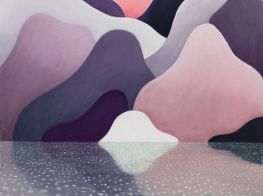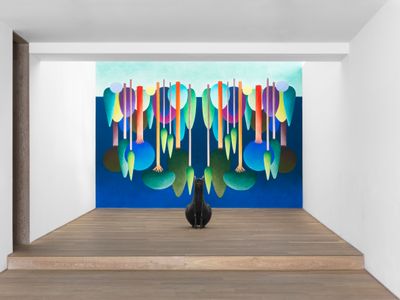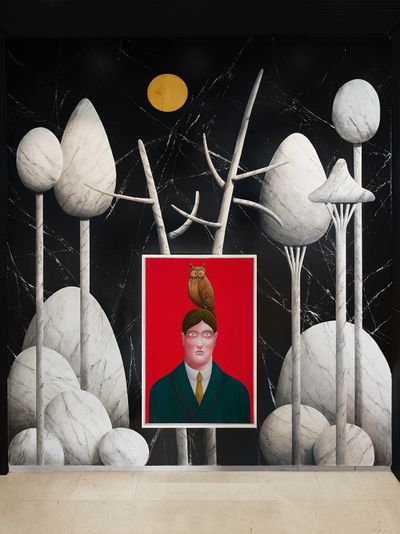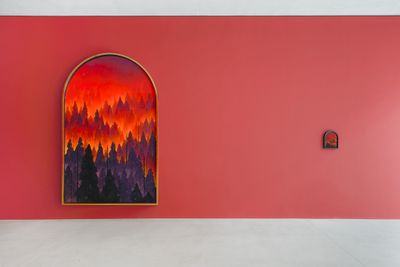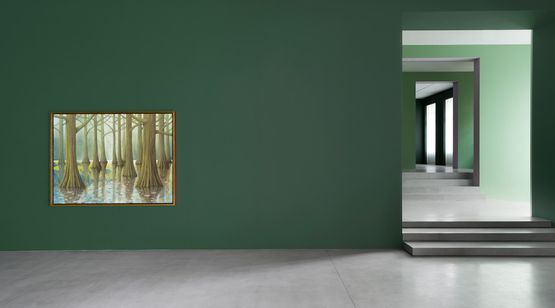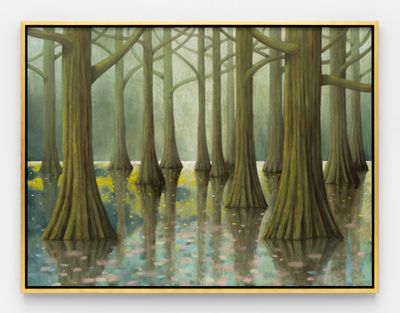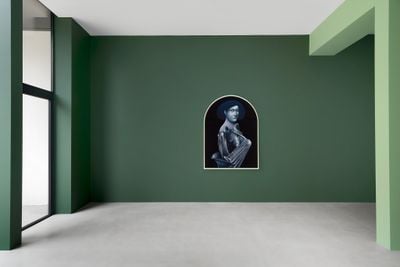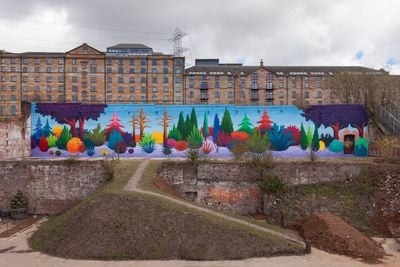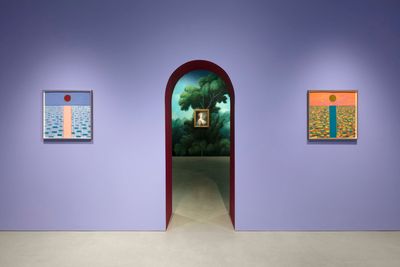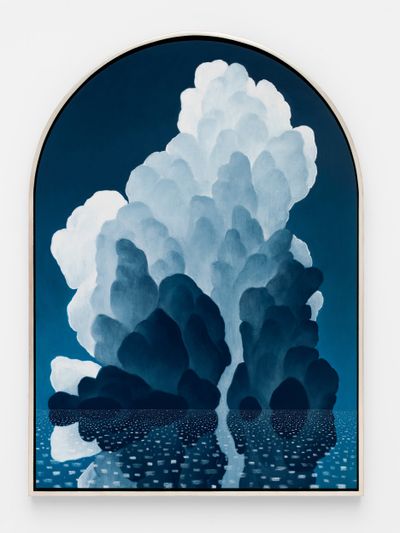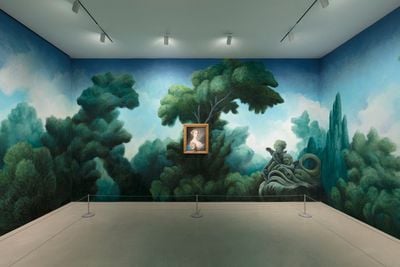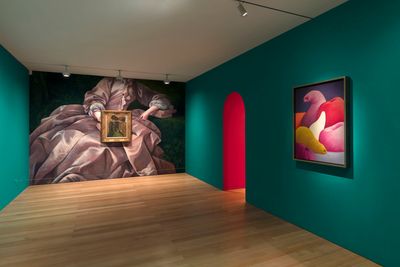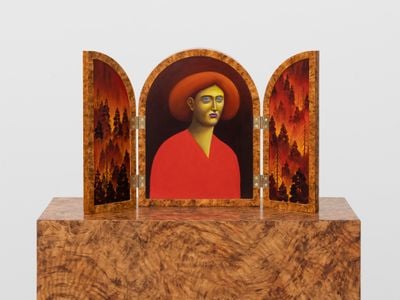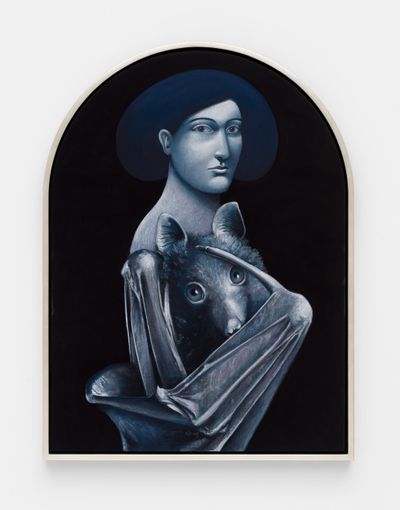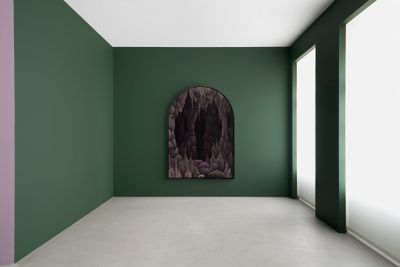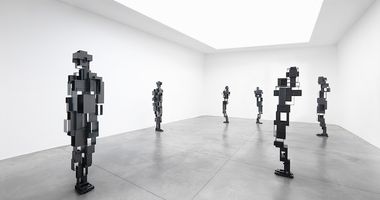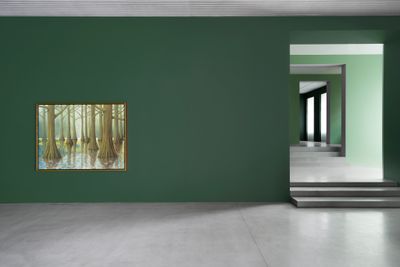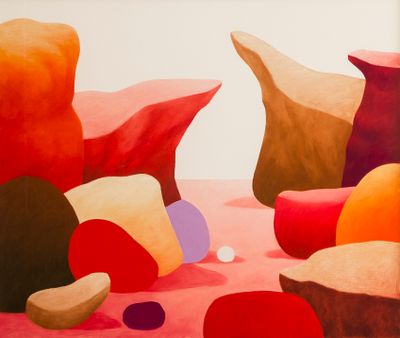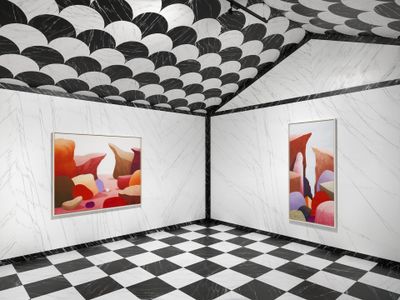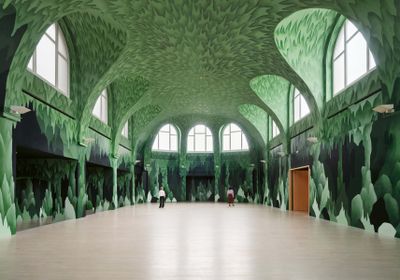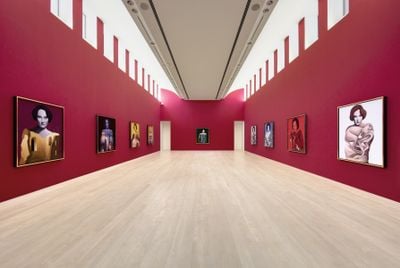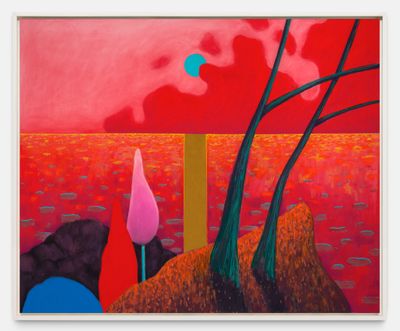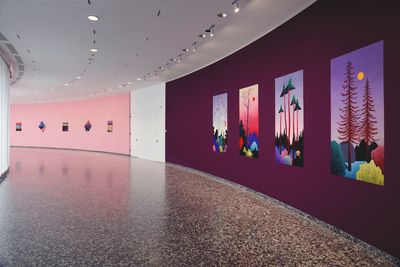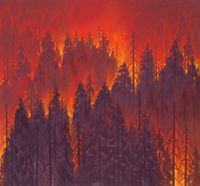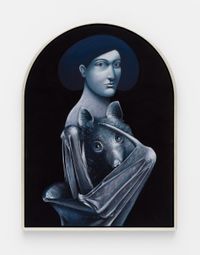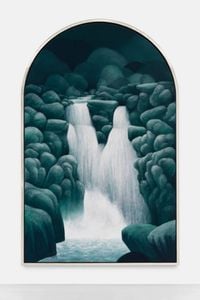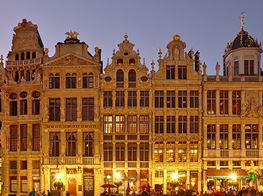Nicolas Party's Journey Through Art
Nicolas Party. Courtesy the artist and Xavier Hufkens, Brussels. Photo: Axel Dupeux.
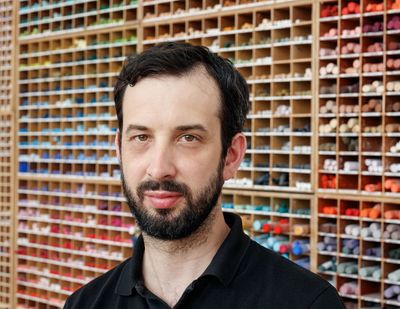
Nicolas Party. Courtesy the artist and Xavier Hufkens, Brussels. Photo: Axel Dupeux.
Painting his earliest scenic vistas at a young age from the landscapes surrounding his hometown of Lausanne, Nicolas Party would later journey from Switzerland to Glasgow, Brussels, and New York to achieve international recognition.
The celebrated painter, sculptor, and installation artist gained attention early in his career for Landscape (2013), a public mural in Glasgow. As a teen in Lausanne, he would tag trains and paint murals, later turning these exercises into innovative wall works for galleries and museums around the world.
Party gave up graffiti when he entered college at the Lausanne School of Art and went on to earn his MFA at the Glasgow School of Art in 2009. Once out of school, he explored various genres and mediums in his early exhibitions at Glasgow's The Modern Institute, the first of six international galleries that currently represent the artist.
After six years in Glasgow, Party continued his nomadic journey to Brussels, where he established his studio and began researching the history of pastels, a medium that he would soon make his own.
Creating vibrant imagery that is highly formal and slightly surreal, Party mined a range of art historical references while making uncanny works for solo shows in New York, Zurich, Milan, and Los Angeles before having his first solo exhibition at Xavier Hufkens in Brussels in 2017.
The exhibition, Three Seasons, led to a game-changing presentation of Party's whimsical pastels and sculptures at Brussels' Magritte Museum, in dialogue with works by legendary surrealist René Magritte.
Incorporating architectural installation into his bag of tricks in Pastel, his 2017 solo show at Karma, New York, Party broke up the gallery's rectangular space with painted walls and arched doorways to create thematic groupings of his compelling works.
Forming immersive environments that transform the modernist white box into colourful realms for visual contemplation—a mode of presentation that beckons back to Fra Angelico's frescoes at the Convent of San Marco in Florence—Party has gone on to create a string of sensational shows for museums and galleries worldwide.
Returning to Brussels for Cascade (27 January–4 March 2023), Party's third solo show with Xavier Hufkens, the artist presents new oil-on-copper paintings, a series of painted cabinets, and his signature pastels on linen, many echoing the cabinet's iconic arched form.
PLWhat was your first tool for making art?
NPI don't recall my first mark-making tools, but I would say crayons because of the colours. Kids love colour. I have many tools in my studio in front of me, which is very inspiring. I also painted as a kid, which I'll be experimenting with soon enough with our daughter.
PLWhat did you make?
NPIt depends on the stage. I did street-art graffiti from the age of 12—classic letters, but also caricatures like monsters and comic-book characters. At age nine or ten, I made many landscapes, going out with watercolours to paint the surrounding vineyards, lakes, and mountains.
My parents saw that I was interested in art and gave me books on landscape painting. I started making oil paintings around the age of 14.
PLHow did your watercolour landscapes and graffiti inform your later practice?
NPIt's fascinating because what I'm doing now is pretty much a mix of the two. The graffiti was super graphic, with very bright colours and hard-edged design, while my landscapes were more traditional. I strongly see the influence of graffiti in my current work; yet again, this love for the tradition of figurative art.
Art history is very present in my work. While I was doing graffiti, I was going to museums and looking at 20th-century painters. I stopped graffiti when I started art school at the age of 21. From then, it probably took me a good ten years to figure out what I really wanted to do.
PLYour first major work, Landscape (2013)—a massive mural on a garden wall in Glasgow, seems to have set you on a path with colours and shapes. What inspired the mural?
NPLandscape is a perfect example of the merging of the two; it was created with spray paint, using the skill that I learned as a teenager.
At that point, among other things, I was inspired by David Hockney's Yorkshire landscapes. He used bright colours, even though they were used more realistically. He was painting actual landscapes, whereas my mural was purely imaginative.
PLWhen did you start working with pastels, and what inspired the move?
NPIt was when I moved to Brussels from Glasgow, around ten years ago. I was using oil paint, but my process was very slow. I wanted to work faster. By chance, I saw Tête de Femme (1962), a pastel by Picasso from his Neoclassical period, in his Basel retrospective.
Picasso is not really a pastel artist, but I loved this portrait. When I returned home, I bought pastels and paper, and made a portrait based on that little piece. It was love at first sight. The medium was much more immediate; all the colours were there and you could work with your hands.
I didn't know anything about pastel, but when I got to know the medium, its history, and some of the artists who worked with it, I really got deeply into it.
PLYour works depart from art history, ranging from Greek and Roman statuary to Renaissance and Modernist masters. What references have you tapped into for your exploration of portraiture?
NPBecause I started by looking at this particular Picasso, a post-Cubist work referencing Greek sculpture, I went to the same source. I saw the face of Greek sculpture as an ideal face that echoed our world of filters and Photoshop. I was attracted to a face beyond age and gender, and intrigued by the mask of idealised beauty. It's fascinating, but also very creepy and haunting.
My reference for portraiture has never been Rembrandt's soulful portraits. I'm more influenced by the Rococo and the figurative pastels of Rosalba Carriera, a 17th and 18th-century artist who painted a sort of aesthetic mask. People wore so much makeup in that period, they basically had a mask. Manufacturers producing the makeup were also the ones creating the pastels.
When Carriera painted a portrait, she was ultimately painting a painted face. People covered their faces to look like someone or something else. There's an echo of that in the modern world, where this mask has become a digital mask.
PLYour subjects appear androgynous. Are they depicted as such to appeal to both genders?
NPMy subjects are androgynous because that's whom I want to talk to when I'm painting. I feel more comfortable painting a person that is not gendered in my head. It's more open for me. Maybe it's the same for audiences; they can figure it out for themselves.
If I paint the hair below the ears, people say it's a woman. If I paint it above the ears—even if it's the same face—people think it's a man.
When I paint, I don't want to know. It's like having a conversation with someone that you hang out with for a few hours, days, or weeks—you want to get to know that person. It's the same when painting a subject, I want to tell it things, but I also want the subject to tell me things and ask me questions.
PLWhat's the significance of the arch form, which you use in your painting supports in this show, and have featured in the passageways of your larger installations?
NPI initially made the arched doors after the Convent of San Marco in Florence, which has the Fra Angelico frescoes. The arches work well there. When you go through an arch, you sense the weight of the wall pressing on your shoulders. It humbles you a bit. I really liked that feeling.
It's one way I alter the architecture of a space. It adds to the experience of the show, like painting the wall a certain colour. It's a simple and obvious trick, but it works for me.
More recently, I used the arch format in a series of little triptych cabinets for Triptych, my 2022 show at the Poldi Pezzoli Museum in Milan, which related to a portable altar from 1500 to 1600 in the collection. There are different shapes, but it's often an arch with two doors that close on it.
I made five cabinets, which are displayed on faux-marble pedestals for the Xavier Hufkens show, and panel paintings—both large and small—in the arch format. I'm not going to become an arch painter, but it created a formal connection between the works. It's really one of the themes of the show.
PLYou are also showing oil-on-copper paintings. Is this a new way of working for you?
NPYes. My last show at Xavier Hufkens, prior to the pandemic, was partially inspired by the 17th-century Flemish artist Jan van Kessel the Elder, and through my research, I discovered his paintings on copper.
Looking at his work and going to museums to see other paintings on copper, I became quite attracted to the medium. I made one and decided to explore the medium further by reproducing my favourite pastels from the last ten years, on a smaller scale with oil-on-copper panels.
Painting on copper is a much longer process than the pastels because there are so many layers of paint. It takes months to do just one. They are smaller versions of the pastels, but they are visually much slicker. I also used copper panels for the paintings in my cabinet works.
PLIn the cabinet pieces, what are you trying to communicate by juxtaposing bats, snails, and sea horses with androgynous subjects?
NPBy putting strong Symbolist elements into the portraits, a story or myth can be created. I've previously done portraits in which the torso is made up of different elements, including a series of paintings with Marlene Dietrich's face with animals and curtains, or an inverted figure from an Otto Dix painting.
I use Symbolist elements like sponges full of meaning. It's a history that's been used in books, novels, and religious tales, but my references—with snails, bats, seahorses—are different from others. I let them carry their own baggage. I don't dictate what they convey.
PLIs your present depiction of ruins and fires related to the state of the world right now?
NPYes, but that wasn't the origin. For my 2021 show at MASI Lugano in Switzerland, I painted ruins based on the ruins in 19th-century Swiss artist Arnold Böcklin's paintings. His are more romantic, haunting ruins—the ones I'm painting are more modern. I mainly used images from World War II.
I guess in Ukraine, the buildings do look a bit like World War II buildings falling, but I was painting ruins before the war began. It's the same with fire. If you have a painting with fire, people think about global warming. If someone sees it that way, it's totally fine, but the history of painting is full of fires.
PLYour research for one body of work seems to lead you into the next. With that in mind, might anything from this show's making carry forward?
NPYes, the theme of the swamp. It's something that I'm working on a lot right now. I've been researching different painters who painted swamps—I love the swamps in 19th-century British literature, like Charles Dickens and Emily Brontë.
There's obviously an echo with what's happening now in the environment, with wetlands disappearing because we thought they were useless. There are southern myths of the swamp too, related to the history of slavery.
The waterfall is also a new theme to further explore. There's only one in the show, but I made several sketches. I want to do woodcuts of a waterfall. So those are two themes that will be sticking around.
PLThere is a fair amount of René Magritte references in this show, a painter you often return to when exhibiting in Belgium. Why is that?
NPI love Magritte. It's difficult to not be inspired by him—maybe unconsciously—when I go back to Brussels. The torsos made of objects could be seen as surrealist. It's the idea of putting two things together that don't normally go together—Magritte often did so, and probably the best.
I grew up with a Magritte poster in our kitchen. He's a remarkable image-maker and a master of mystery. He will never tell you what he means. When he puts three things together and you see something very sexual or haunting, it's up to you. And his titles are as open as his paintings.
I had a fantastic experience doing a show at the Magritte Museum in 2018. My mural for the show is still on view there.
The things I use are much more charged than his everyday objects. As I mentioned, I don't shy away from using symbolic objects with a lot of baggage. I put them there to see what happens—maybe it's too much, maybe not. When I see them, it's fine. But it's not up to me to decide.
PLWhat other artists have repeatedly inspired your work?
NPRosalba Carriera is a huge one since I've worked with pastel. She is the best pastel artist that I know of, who made a lot of portraits. She creates very haunting, complex surfaces with the medium.
Félix Vallotton was a huge inspiration. He also had a very clear distinction between still lifes, landscapes, portraits, and nudes. But I dislike when he puts figures in his landscapes. I always want to remove them.
And Georgia O'Keeffe; I love how she's absolutely not shy to use something that people might find scary, like bones or a skull. If things are being painted a lot—like a seashell, it's because they are actually amazing objects that communicate to us.
I've been looking at American artist Arthur Dove for my recent murals, which are much more abstract. So, it comes and goes, but Carriera and Vallotton have been with me for a while. Some of the Renaissance masters too. I'm always happy to go back to Giotto.
PLI love the relationship between your sunsets and Vallotton's. Do you filter them through the lens of street art and digital art, where the colours and forms are further reduced?
NPFor my 2017 show sunrise, sunset at Hirshhorn Museum, Washington, that's literally what I did. I sampled paintings from different artists and painted them directly on the wall.
I took a Vallotton landscape and simplified it because I was making it quickly. The straight line in my sunset paintings is from his. It's almost the same painting with tiny tweaks—especially the colours. I never feel shy about it. If I love something and it goes well, it makes a new artwork.
PLPicasso and Warhol did the same thing.
NPIf you paint portraits or trees, you bring in very little that's new. You're just adding to what's already been done. Hopefully, it echoes something of the time now.
Maybe some artists have a different idea. But once I realised being original was not what I was supposed to do, it made me feel free and more relaxed.
In art school, I thought I needed to find a signature style or a subject that no one had painted. Then I realised I was going to paint still lifes and landscapes. If they look exactly like Vallotton's, at least that's what I want to do. And if someone else wants to see them, that's a start. Then it grows. —[O]

